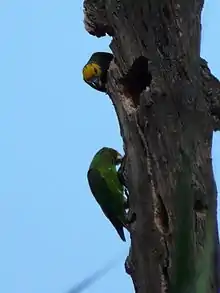Yellow-fronted parrot
The yellow-fronted parrot (Poicephalus flavifrons) is a parrot endemic to the Ethiopian Highlands.[1] It is a mostly green with a yellow head. Relatively little is known about this bird.
| Yellow-fronted parrot | |
|---|---|
 | |
| Adult in Ethiopia | |
| Scientific classification | |
| Kingdom: | Animalia |
| Phylum: | Chordata |
| Class: | Aves |
| Order: | Psittaciformes |
| Family: | Psittacidae |
| Tribe: | Psittacini |
| Genus: | Poicephalus |
| Species: | P. flavifrons |
| Binomial name | |
| Poicephalus flavifrons (Rüppell, 1845) | |
Taxonomy
German naturalist Eduard Rüppell first described the yellow-fronted parrot in 1845. Its species name is derived from the Latin words flavus "yellow", and frons "forehead".[2] It is also known as the yellow-faced parrot. Most recent authorities treat it as monotypic,[3][4][5] but some recognized two slightly different subspecies, P. f. flavifrons and P. f. aurantiiceps.[6]
Description

The yellow-fronted parrot is about 28 centimetres (11 in) long and is mostly green with the upper parts being a darker green, the tail being olive-brown, and the legs a dark grey-brown. The face is orange-yellow. When two subspecies are recognized, the nominate is believed to have yellow to its head and face, while in P. f. aurantiiceps some of the yellow is replaced with orange.[6] The upper beak is brownish-grey and the lower beak is bone coloured, the irises are orange-red, and bare eye-rings and cere are grey. Male and female adults have identical external appearance. Juveniles are duller than the adults with a mostly grey head, brown irises, and only a small amount of yellow on the front of the face including on the forehead.[6]
Range
This parrot is endemic to the Ethiopian Highlands at about 1,000–3,000 metres (3,300–9,800 ft) above sea level.[6] When two subspecies are recognized, the nominate is found in the highlands around Lake Tana and also in central Ethiopia, and P. f. aurantiiceps is found in southwestern Ethiopia.[6] It lives in forest habitats, unlike most other Poicephalus parrots apart from the Cape and red-fronted parrot superspecies complex.[7]
Aviculture
The yellow-fronted parrot is unknown in aviculture.[8]
References
- BirdLife International (2012). "Poicephalus flavifrons". IUCN Red List of Threatened Species. 2012.CS1 maint: ref=harv (link)
- Simpson DP (1979). Cassell's Latin Dictionary (5th ed.). London: Cassell Ltd. pp. 250, 256. ISBN 978-0-304-52257-6.
- "Zoological Nomenclature Resource: Psittaciformes (Version 9.023)". zoonomen.net. 27 November 2010.
- Dickinson, E. C. (editor) (2003). The Howard and Moore Complete Checklist of the Birds of the World. 3rd edition. ISBN 0-7136-6536-X
- Clements, J. F. (2007). The Clements Checklist of the Birds of the World. 6th edition. ISBN 978-0-7136-8695-1
- Forshaw (2006). plate 67.
- Massa, Renato; Sara, Maurizio; Piazza, Matteo; Di Gaetano, Cornelia; Randazzo, Margherita; Cognetti, Goffredo (2000). "A molecular approach to the taxonomy and biogeography of African parrots" (PDF). Italian Journal of Zoology. 67 (3): 313–17. doi:10.1080/11250000009356330. S2CID 84641647.
- Mattie Sue Athan; Dianalee Deter (2008). Guide to the Senegal Parrot and Its Family. Barron's Educational Series. p. 17. ISBN 978-0-7641-3886-7.
Cited texts
- Forshaw, Joseph M. (2006). Parrots of the World; an Identification Guide. Illustrated by Frank Knight. Princeton University Press. ISBN 978-0-691-09251-5.
